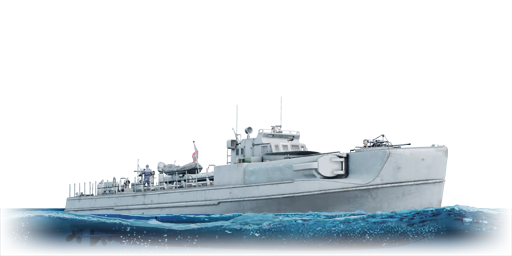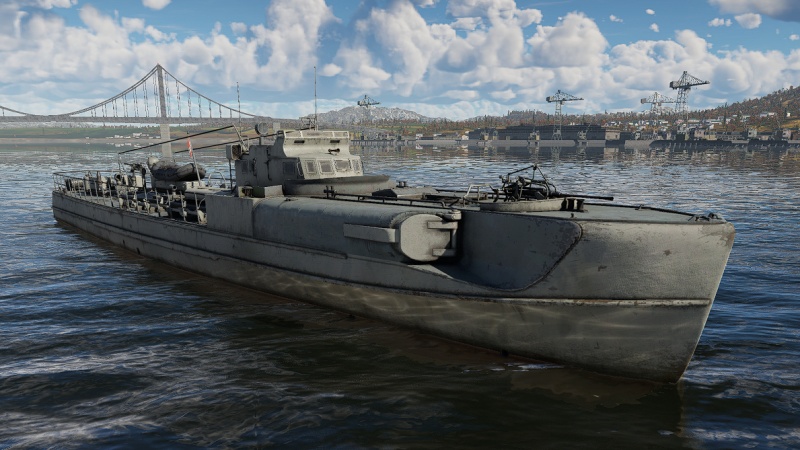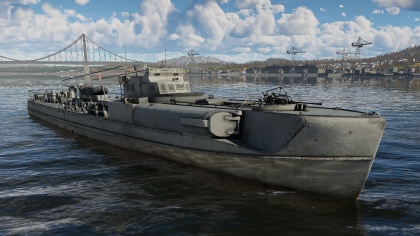S-38
Contents
Description
The S-38 is a rank I German motor torpedo boat
with a battle rating of 1.3 (AB) and 1.7 (RB/SB). It was introduced in Update 1.79 "Project X" as part of the fleet closed beta test.
General info
Survivability and armour
The S-38 is a wooden-hulled vessel with a steel superstructure. The S-38 offers little resistance to damage as a result of its construction. The S-38 has a crew of 31, which means the S-38 can absorb reasonable amounts of damage when fired upon. Fire is a tangible threat on the S-38 because of its wooden hull. Due to the long construction of the ship, the crew is fairly spaced out. However, it is worth mentioning the S-38's bridge and radio station are in close proximity, meaning if one is damaged, it is likely the other will be damaged soon after.
Ammunition storage is near the main guns. The ammo racks are fairly large targets and, due to the limited protection offered by the hull, can easily be hit. The ammo is also near the ship's fuel tanks and radio room, meaning if an enemy vessel is firing upon either, they could easily strike the ammo racks.
Mobility
The S-38 is a quick boat, capable of achieving roughly 101 KPH (63 MPH) forwards in arcade, and 33 KPH (21 MPH) in reverse. The vessel's acceleration is good, and the S-38 has a tight turning radius. Due to the balanced distribution of the ship, it will not roll too far when turning. The boat has a shallow draft that makes fighting in shallow waters and littorals possible.
It is fair to say the ship is capable of getting itself into and out of combat quickly.
Modifications and economy
Armament
Primary armament
The S-38 carries two 20mm automatic cannons. The S-38's weapons are, in proper hands, effective against enemy boats and aircraft. They have small magazines of 40 and 20 rounds respectively. The rearward cannon will run out of ammunition when the frontal cannon is half way through its magazine. Overheating is not a concern with these cannons; they do not overheat. Being small cannons, the S-38's 20mms traverse quickly, and offer decent angles of fire.
When upgraded, the S-38's 20mm cannons are noteworthy. They should not be used beyond ranges of .8 Km (.5 Mi).
Torpedo armament
The S-38 carries two G7a torpedoes, which are launched from tubes that are integrated into the front of the hull. The tubes are mounted at very shallow angles. The torpedoes are better used on slow targets, or at extreme ranges. These torpedoes have a slight blind spot in the front of the ship, but this blind spot is often negligible.
The G7a has a range of roughly 6 Km (3.73 Mi) and travel at a speed of 82 KPH (51 MPH) when stock. The upgraded torpedo travels slower at 56 KPH (35 MPH), yet travel up to 14 Km (8.7 Mi). The G7a is packed with the equivalent of 358.4 Kg TNT (790.1 Lb. TNT), and strike at the waterline, meaning the torpedo will deal fatal damage to most maritime targets.
Special armament
The S-38 can carry 6 WBD depth charges, which carry 130 Kg TNT (286 Lb. TNT) of explosive power. When used skillfully, these charges can be used to deal away with pursuers, or destroy inattentive enemies.
Additional armament
Describe the available additional armaments of the ship: depth charges, mines, torpedoes. Talk about their positions, available ammunition and launch features such as dead zones of torpedoes.
If there is no additional armament, remove this section.
Usage in battles
The S-38 is often used for rushing capture points. This is one use for the boat. The S-38 can be used to deliver surprise attacks, and deal away with targets behind enemy lines; the vessel is quick enough to speed past enemies and take "long ways" around enemy vessels. Using the S-38 in frontal, or even close, combat is not advisable. Though the main cannons traverse quickly and deal notable damage, the hull is too fragile to support sustained frontal engagements. It is also not advisable to engage more than one target at once. The S-38's cannons are not suited for fighting in numerical inferiority. Either chose lone targets, or operate in larger groups.
Modules
| Tier | Seakeeping | Unsinkability | Firepower | |||
|---|---|---|---|---|---|---|
| I | Dry-Docking | Tool Set | 20 mm HET magazines | |||
| II | Rudder Replacement | Fire Protection System | Smokescreen | 20 mm APT magazines | ||
| III | Propeller Replacement | Depth Charges | Primary Armament Targeting | |||
| IV | Engine Maintenance | New Pumps | Torpedo Mode | Artillery Support | ||
Pros and cons
Pros:
- Very mobile
- Cannons offer effective stopping power for single target engagements
- Torpedoes are very viable in combat, as they are mounted conveniently and deal significant damage
- Inexpensive to operate
- Good crew size of 31
Cons:
- Hull offers minimal protection
- Key components are close together (ammo is near engines, radio room is near the bridge)
- Cannons have limited capacity per magazine
- Does not do well in numerical inferiority
- No anti-air cover beyond the main cannons
History
The S-38 was developed and built by the German Lürssen Werft in 1938/1939. In total, 8 units of the standard S-38 were built, followed by 16 units of the improved -B variant (see S-38b). Its main use was to protect German convoys in the Baltic Sea as well as attacking Soviet ships. The S-38's plans were later used for the development of the Silbermöwe class in 1952.
The information below comes from the interrogation of the crew after their capture.
The S-38 was the lead ship of the S-38 class of Schnellboots (S-boots).
S-38 was laid down at Lürssen Yards, Vegesack, as one of the series of S-boots laid down in 1937-1938 (S-32 to S-45). S-38 was commissioned in mid-October, 1940. Her first assignment was to the 1st S-Flotilla, operating out of Kiel, as a replacement for S-19; S-19 had struck a mine in August and had to be towed to Calais.
On 9 November 1940, S-38 left Kiel for Borkum, travelling unaccompanied through the Kiel Canal. The ship spent the night in Borkum, and was then towed through the North Sea Canal from Delfzijl and Groningen to Zuyder Zee. She had to be towed through the canal because her minimum speed (even on only one engine) was 9 knots. S-38 arrived at Amsterdam and then proceeded through more canals to Rotterdam, arriving on 14 November 1940. No patrols were carried out until 19 November.
On 19 November 1940, S-38 and several other S-boots left Rotterdam at approximately 1700, and they separated at 2000. On this mission, S-38 was equipped with only 2 torpedoes in the tubes and two more at the ready. The crew described the mission as a patrol, with orders to sink any merchantman they found. S-38 reached the patrol area at 2130. The moon was shining brightly, but visibility was hindered by mist.
At 0158 BST on 20 November, HMS Campbell and HMS Garth (destroyers) sighted S-38 approximately 12 miles east of Southwold.
The crew of the S-38 first spotted one of the British destroyers to the starboard side. It seemed far away through the mist, but it soon became clear that it was steaming right towards them and was only 400 meters away. S-38 sent out a message to another S-boot warning them of the British ships.
S-38’s commanding officer ordered the ship to turn starboard in order to fire the starboard torpedo tube. For some reason, the torpedo was unable to be fired immediately, so the ship was turned to port, as was the tactic after an attempted torpedo attack. During that turn, a torpedo was launched without aim, and it is unknown which torpedo tube fired. At that point, the Germans first saw the second British destroyers off the port side.
According to the German crew, the British had not spotted S-38 up until that point. Once they had spotted the S-boot, Campbell opened fire with close range weapons, hitting S-38’s port side. The bow and the starboard torpedo tube were damaged, while the steering gear, lighting system, engine room telegraph and fuel tank were also hit. According to the crew, S-38 was hit by seven or eight shells.
In an attempt, the smoke generating system was turned on, but S-38 could only turn in a slight curve due to the damaged steering gear. The fuel tank caught fire, and one of the engines was knocked out. A few of the crew jumped overboard after the fire started.
With the intention of dropping depth charges into the path of the destroyers, a crewman ran aft but was forced to abandon that plan after the British opened up with machine guns. The crew was forced to hit the deck and take cover behind whatever they could - mostly using the spare torpedoes - to avoid the machine gun fire. Campbell passed only 20 m in front of the bow of the ship, continuing to rake it with machine gun fire. Under such heavy fire, the crew of S-38 did not attempt to return fire.
Pinned down and caught in the beam of a British searchlight, the German commanding officer ordered the German war flag to be hauled down. The crew attempted to pull the wounded to the stern, as the ship was at that time sinking bow-first.
S-38 sank at 0225; the crew claimed that the ship did not capsize, contradicting the British account of the action. Out of the crew of 23, 5 men were killed, with the other 18 being rescued by the British destroyers. Seven crew members and all three officers were wounded while the other eight sailors were unharmed.
Media
An excellent addition to the article will be video guides, as well as screenshots from the game and photos.
See also
Links to the articles on the War Thunder Wiki that you think will be useful for the reader, for example:
- reference to the series of the ship;
- links to approximate analogues of other nations and research trees.
External links
Paste links to sources and external resources, such as:
- topic on the official game forum;
- encyclopedia page on ship;
- other literature.
| Germany boats | |
|---|---|
| Motor torpedo boats | LS 3 · LS 4 Esau · KM-5 · VS-10 |
| S-38 · S-38b · S-100 · S-147 · S-204 Lang · S-701 | |
| R-301 | |
| V-990 | |
| Jaguar · Hugin · Pfeil | |
| Motor gun boats | R-41 · R-130 · Krischan der Große |
| Motor torpedo gun boats | Albatros · Bussard · MZ1 · Pr. 206 |
| Minelayers | VS-8 |






